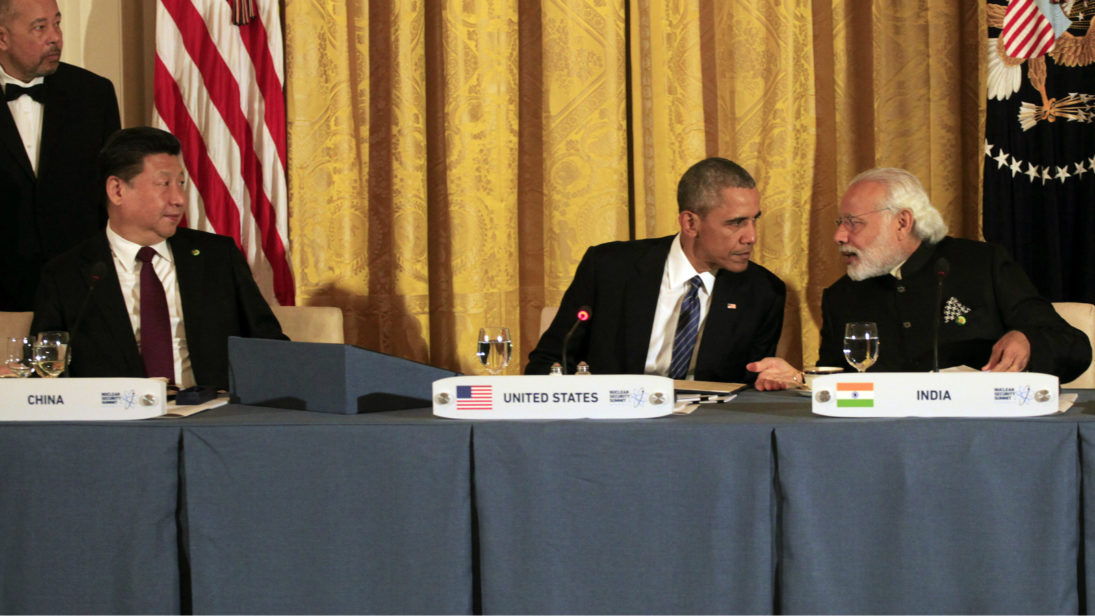
Earlier this month, when Indian Defense Minister Manohar Parrikar and U.S. Defense Secretary Ashton Carter agreed in principle to sign a logistics support agreement (LSA) intended to enhance military ties, many in India wondered if the pact would push the country into an unnecessarily tight embrace with the United States. More importantly, they worried that an increasingly assertive China would not tolerate such dalliances. In this context, many presumed that the high-level interactions between Indian and Chinese officials, incidentally scheduled for right after the Carter visit, would be designed to make nice with Beijing. However, this was far from the case.
Soon after Secretary Carter’s visit to India, Minister Parrikar went on his maiden trip to China while External Affairs Minister Sushma Swaraj met with her Chinese counterpart in Moscow. National Security Advisor Ajit Doval was also in Beijing for the 19th round of India-China boundary talks. With none of them did the Chinese harp on about the logistics agreement.
Only the state-run Global Times ran an opinion piece to coincide with Parrikar’s visit. It noted that while “traditional distrust” between India and the United States was one of the reasons why the LSA was yet to be signed, India, in the game of superpowers, “would like to continue to be the most beautiful woman wooed by all men.” This was only a tad bit stronger than the Chinese Foreign Ministry spokesperson’s anodyne comments after the LSA was announced the week before.
Beijing’s decision to underplay the pact is interesting, because, even if in a limited sense, the LSA does have a bearing on Chinese strategic calculations. Officially known as the Logistics Exchange Memorandum of Agreement (LEMOA), the pact will institutionalize India-U.S. military activities, particularly between the navies. It won’t add much to the existing range of activities (such as berthing, re-fueling, and servicing at each other’s bases), but will serve to put these on auto-pilot instead. It will also put in place a system to settle payments collectively instead of individually. This will certainly help the U.S. Navy, which plans to deploy 60 per cent of its surface ship in the Indo-Pacific in the near future.
For India, the big benefits, almost entirely in the form of technology, will come more from the other ‘foundational agreements’—Communications and Information Security Memorandum of Agreement (CISMOA) and Basic Exchange and Cooperation Agreement (BECA) for Geospatial Intelligence—as and when (and if) they are signed. This technology will be especially key, experts argue, for the Indian Navy to maintain an asymmetric advantage over the Chinese, at least in the Indian Ocean.
So, why isn’t China raising a hue and cry over this? For two reasons: First, it’s still early days. CISMOA is still being discussed while BECA is yet to jump the sovereignty hoop and make it to the negotiating table. More importantly, LEMOA has been finalized but not signed. Second, the very expectation that China will go ballistic (and perhaps retaliate with aggressive posturing along the border, much of which is disputed) is overblown. Consider this: A tiny nation like Sri Lanka, where China has made multi-million dollar investments, has signed the LSA with the United States without so much as a pipsqueak from Beijing. Meanwhile, India has gained nothing by pussyfooting around an increasingly belligerent Beijing in recent years. China has only upped the ante with repeated transgressions along the border.
The regime in New Delhi understands this, and thus the Modi government is trying to face China with a more confident and self-assured avatar. This explains why one of the biggest issues on the Indian agenda in Beijing (and Moscow) this past week was Jaish-e-Mohammed chief Masood Azhar. In order to shield its all-weather friend Pakistan, China blocked India’s efforts at the United Nations to tag Azhar (believed to have links to sections of the Pakistani state) as a terrorist, and India is rightly raising a stink over it. The issue was highlighted repeatedly by all three Indian officials—Parrikar, Doval, and Swaraj. At the same time, India reportedly gave a visa (later cancelled) to a prominent Uighur activist who China considers a terrorist, to attend a conference in Dharamsala.
Those worrying that such measures would derail the India-China bilateral should note that both countries have now agreed to set up a hotline at the level of Director-General Military Operations and establish at least one more border meeting point. Sure, these are small confidence-building measures, but the border question was not going to be resolved overnight anyway.
That said, a note of caution for India is in order as well. If New Delhi wants to play the great game, it needs to look at the larger picture and think big. Did it make sense to invest so much precious diplomatic bandwidth in China on Masood Azhar, important as it may be to pursue the case against him? After all, in India’s larger fight against terrorism emanating out of Pakistan, UN sanctions will be more symbolic than substantial. 26/11 mastermind Hafiz Saeed’s case is proof.
Instead, India needs to focus on the large-scale military reforms underway in China. President and now Commander-in-Chief Xi Jinping is preparing his men not only for the next war but also to bolster the country’s aggressive economic forays abroad, through its ambitious One Road One Belt project. India needs a credible response, especially for the Indian Ocean region where it must remain the big power. American support can help significantly in this regard. India just needs to be confident enough to leverage that in its favor.
***
Editor’s Note: Click here to read this piece in Hindi
Image: Dennis Brack, Getty